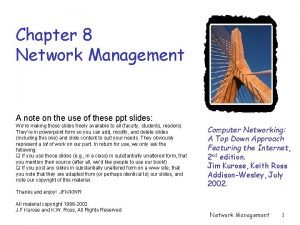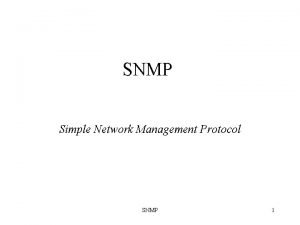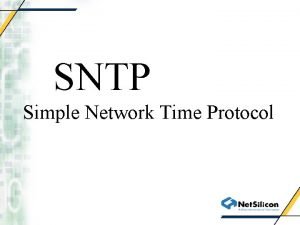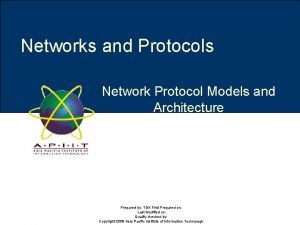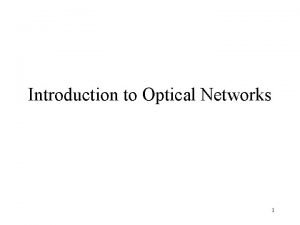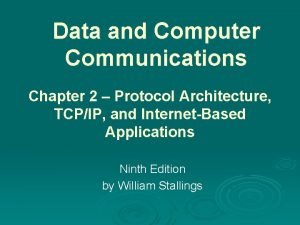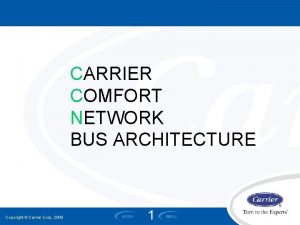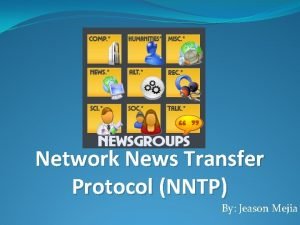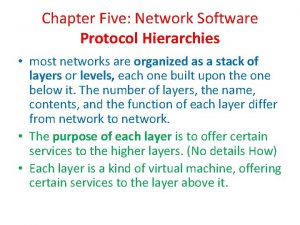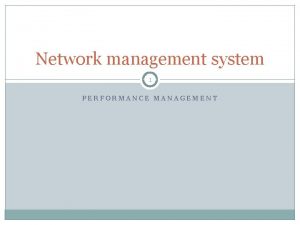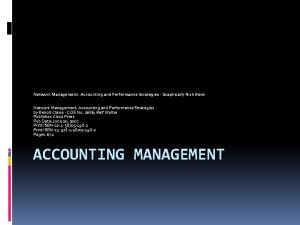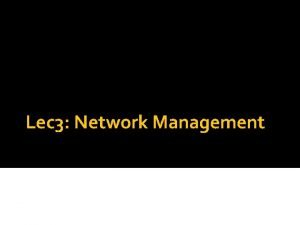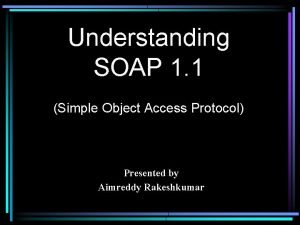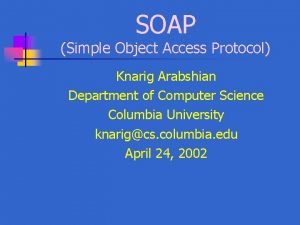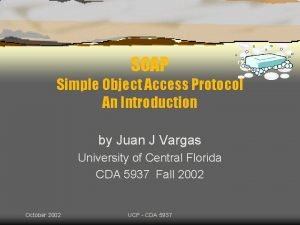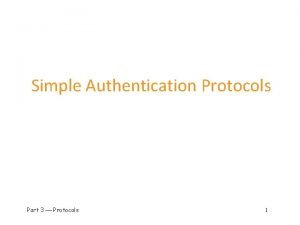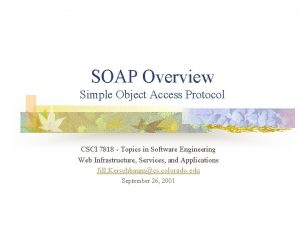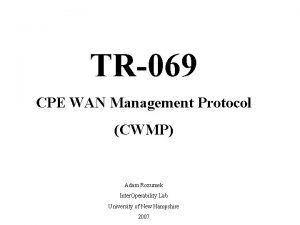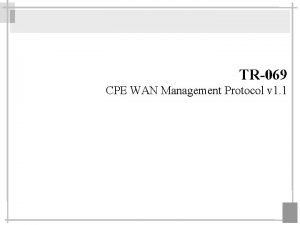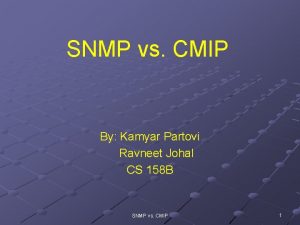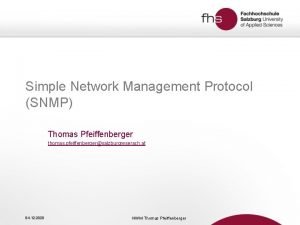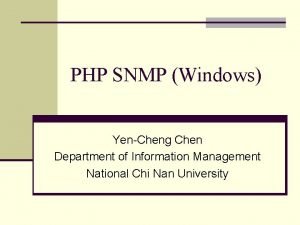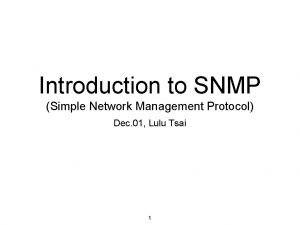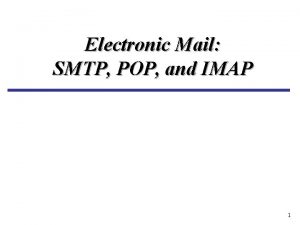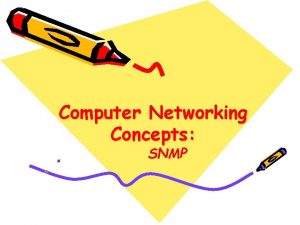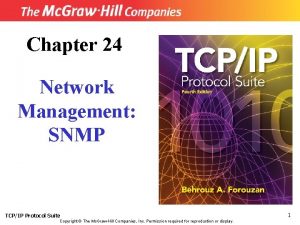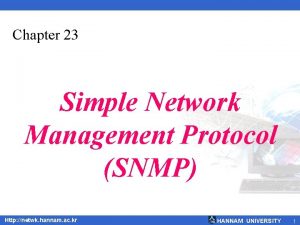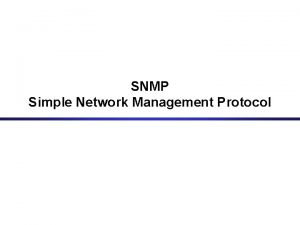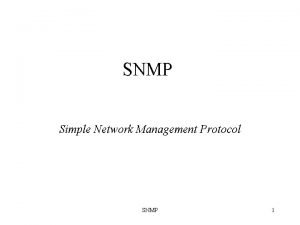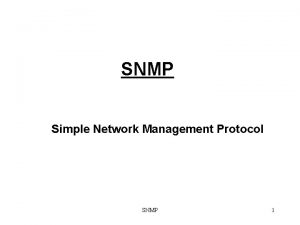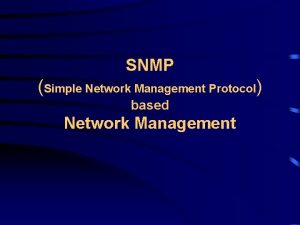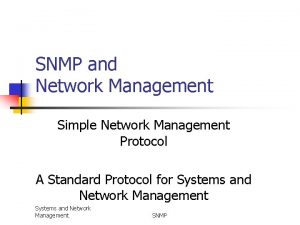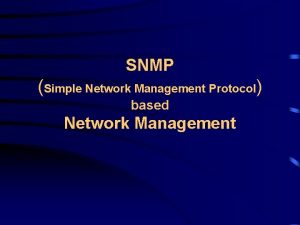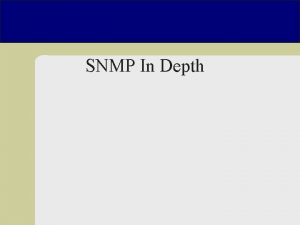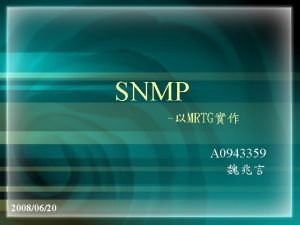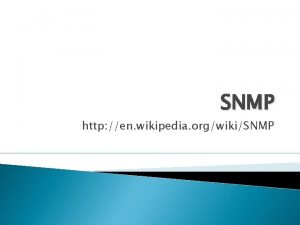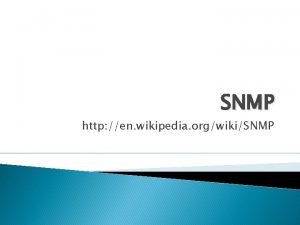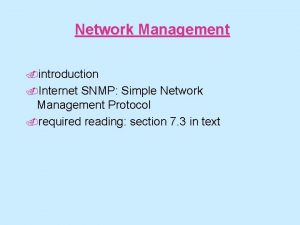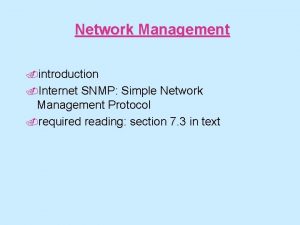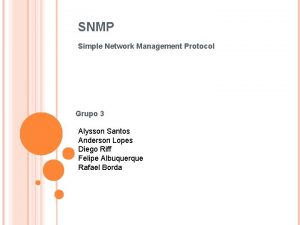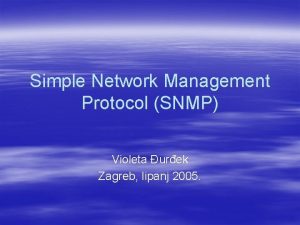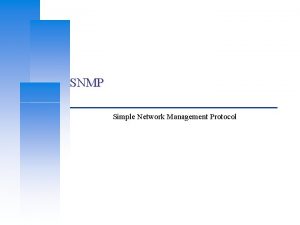SNMP Simple Network Management Protocol SNMP WHAT IS















































- Slides: 47

SNMP Simple Network Management Protocol

SNMP WHAT IS IT?

SNMP n Simple Network Management Protocol ¡ Part of the internet protocol suite n ¡ Defined by the Internet Engineering Task Force (IETF) Used by network management systems n n Monitor network-attached devices for conditions that warrant administrative attention Manage those systems ¡ e/g/ Set or reset their configuration

SNMP n SNMP “exposes” management data ¡ ¡ n n Variables on the managed systems Values within the system Variables can be queried by managing applications Some variables can be set

OVERVIEW AND BASIC CONCEPTS

Overview and basic concepts n Typical SNMP environment: ¡ Large number of systems to be managed n ¡ Via SNMP Agents By one or more system managers n Via SNMP Managers

Overview and basic concepts n An SNMP agent : ¡ ¡ ¡ Software component Runs on each managed system Reports information via SNMP to the managing systems

Overview and basic concepts n SNMP agents reports data of interest on the managed systems ¡ Variables such as: n n n "free memory“ "system name“ "number of running processes“ "default route“ “toner cartridge status” etc.

Overview and basic concepts n Managers can retrieve the information through protocol operations ¡ ¡ ¡ n GETNEXT GETBULK Agents can send data without being asked using special protocol operations ¡ ¡ TRAP INFORM

Overview and basic concepts n Managers can ¡ ¡ n Send configuration updates Send controlling requests Uses the SET protocol operation to actively manage a system

Overview and basic concepts n Monitoring operations: ¡ ¡ Done by managers Usually performed on a regular basis n n E. g. periodic polling Configuration and Control operations: ¡ ¡ Done by managers Only when changes are needed

Overview and basic concepts n SNMP Variables are organized in hierarchies called MIBs ¡ ¡ Management Information Bases Contains the data and metadata describing each variable’s n n type description

MIBs MANAGEMENT INFORMATION BASES

Management Information Bases n SNMP itself does not define the information within a managed system ¡ n e. g. Specific systems variables SNMP is an extensible design ¡ Available information defined by management information bases n ¡ a. k. a. MIBs System designers decide what info is appropriate for a particular device

Management Information Bases n MIBs describe the structure data for a device or class of devices ¡ ¡ n Use a hierarchical namespace containing object identifiers (OID) Each OID identifies a variable that can be read or set via SNMP MIBs use a notation defined by ASN. 1

Management Information Bases n MIB hierarchy can be depicted as: ¡ ¡ n Top-level MIB OIDs belong to different standards organizations ¡ ¡ n A tree with a nameless root Levels which are assigned by different organizations CCITT ISO Lower-level object IDs are defined by their organizations

Management Information Bases n A managed object 1 is a specified characteristic of a managed device ¡ Managed objects comprise one or more object instances which are essentially variables n n 1 Identified by their OIDs sometimes called an MIB object, an object, or a MIB

Management Information Bases n Two types of managed objects exist: ¡ Scalar objects n ¡ Define a single object instance Tabular objects n n Define multiple related object instances Grouped in MIB tables

Management Information Bases n Example of a managed object on an HP printer ¡ Object identifier (or object ID or OID) n n n 1. 3. 6. 1. 2. 1. 43. 9. 2. 1. 1 Identifies the output capacity prt. Output. Index ¡ A scalar object that contains a single object instance n An integer value ¡ 0 or larger n 0 means out of paper

From the top n example ¡ n 1. 3. 6. 1. 4. 1. 11 Start with the top level OID assignment ¡ http: //www. alvestrand. no/objectid/top. html n and work the way down

Other Examples n Resource: ¡ n Example: 3 Com device ¡ n http: //www. mibdepot. com/index. shtml http: //www. mibdepot. com/cgibin/xsearch_index 3. cgi? id=173627 Example 2: ¡ http: //www. oid-info. com/get/1. 3. 6. 1. 2. 1

SNMP BASIC COMPONENTS

SNMP basic components n SNMP-managed networks consist of three key components: 1. 2. 3. Managed devices Agents Network-management systems (NMS)

SNMP basic components n Managed device ¡ Network node that contains one or more SNMP agents n ¡ Collect and store management information n n Make information available to NMSs using SNMP Managed devices ¡ n Resides on a managed network Sometimes called network elements Act as servers on the network

SNMP basic components n Managed devices can be any type of networked device including, but not limited to: ¡ ¡ ¡ ¡ Routers and access servers Switches and bridges Hubs IP telephones Computer hosts Printers File servers Web servers

SNMP basic components n Agent ¡ Network-management software (NMS) module n n ¡ Executable program Resides in a managed device Has local knowledge of management information n Translates that information into a form compatible with SNMP

SNMP basic components n Network Management Systems ¡ ¡ Execute applications that monitor and control managed devices NMS provide n n ¡ n Bulk of the processing Memory resources required for network management One or more NMS may exist on any managed network Act as clients on the network

SNMP oddity: n Typical system has: ¡ Many servers n ¡ Few clients n n n Each managed device on the network is a server Usually one or two Devices that monitor and manage the “servers” “Backwards” from the usual client/server environment

Which are more common in an SNMP environment M s Te ab ag er s 0% Se rv ag i c El ve s 0% w ar E. 5% D D. 48% nt s C. lie B. Clients Dwarves Magic Elves Servers Teabags C A. 48%

SNMP PROTOCOLS

SNMP Versions n n n SNMPv 1 SNMPv 2 SNMPv 3

SNMPv 1 MIB tables n SNMPv 1 defines highly structured tables ¡ ¡ n Used to group instances of a tabular object Object that contains multiple variables Tables are composed of zero or more rows ¡ Indexed in a way that allows SNMP to retrieve or alter an entire row with a single Get, Get. Next, or Set command

Data Types n n n Integer Octet Strings Object IDs

Application-wide data types n Seven application-wide data types exist in the SNMPv 1 SMI: ¡ ¡ ¡ ¡ Network addresses Counters Gauges Time ticks Opaques Integers Unsigned integers

SNMPv 3

SNMPv 3 n SNMPv 3 defined by RFC 3411–RFC 3418 ¡ n n also known as 'STD 0062' SNMPv 3 primarily added security and remote configuration enhancements SNMPv 3 is the current standard version of SNMP ¡ IETF considers earlier versions "Obsolete" or "Historical"

SNMPv 3 n SNMPv 3 provides important security features: ¡ Message integrity n ¡ Authentication n ¡ Ensure that a packet has not been tampered with in transit Verify that the message is from a valid source Encryption of packets n Prevent snooping by an unauthorized source

OTHER SNMP TOPICS

Negative impact n SNMP implementations vary across platform vendors ¡ SNMP is often an added feature n ¡ ¡ Not an element of the core design SNMP's tree structure and linear indexing may not always mate well with the internal data structures that are elements of a platform's basic design Using SNMP to query certain data sets may result in high CPU utilization n n Negative effects on operation One example of this would be large routing tables ¡ such as BGP or IGP

Security implications n SNMP versions 1 and 2 c are subject to packet sniffing ¡ ¡ n The clear text community string from the network traffic No encryption All versions of SNMP are subject to brute force and dictionary attacks for guessing the community strings/authentication strings

Security implications n SNMP's configuration capabilities can be misconfigured and used to cause much damage ¡ 'write' capabilities are very rarely used in practice n ¡ Lack of security is particularly serious with SNMPv 1 or v 2 c over UDP n n Clear text community strings can be intercepted and combined with IP spoofing SNMP tops the list of the SANS Institute's Common Default Configuration Issues ¡ ¡ n Lack of security in SNMP versions before SNMPv 3 The issue of default SNMP community strings set to ‘public’ and ‘private’ Number ten on the SANS The Top 10 Most Critical Internet Security Threats for the year 2000 For more detail on SNMP security implications see the CERT SNMP Vulnerabilities FAQ

Last Notes n n SNMPv 3 is the most secure SNMPv 1 is the most used 1 ¡ n “easiest” Typical systems will try the most secure version first ¡ Then roll back towards v 1 1 https: //www. digitalocean. com/community/tutorials/an-introduction-to-snmp-simple-network-management-protocol (2014)




Summary n n SNMP is a protocol to define a framework for network management tasks By itself is just a definition ¡ Must be “made real” by products

More Info n SNMP Data Types. pptx
 Simple network management protocol ppt
Simple network management protocol ppt Snmp adalah
Snmp adalah Snmp model in computer networks
Snmp model in computer networks Simple ntp
Simple ntp Network protocol architecture
Network protocol architecture In a telecommunications network architecture, a protocol is
In a telecommunications network architecture, a protocol is Dicomn
Dicomn Network protocol architecture
Network protocol architecture Carrier ccn
Carrier ccn Usenet message vanessa
Usenet message vanessa Network protocol vulnerabilities
Network protocol vulnerabilities Network software protocol hierarchies
Network software protocol hierarchies Network performance management system
Network performance management system Accounting management in network management
Accounting management in network management Introduction to network management
Introduction to network management Network management definition
Network management definition Future simple in the past
Future simple in the past Present simple future simple past simple
Present simple future simple past simple Past simple future
Past simple future Present simple past simple future simple present continuous
Present simple past simple future simple present continuous Simple present simple past and simple future
Simple present simple past and simple future Past simple vs past continuous exercises
Past simple vs past continuous exercises Have en futuro simple
Have en futuro simple Present simple exemplos
Present simple exemplos Future simple present simple
Future simple present simple Simple object access protocol
Simple object access protocol Simple object access protocol
Simple object access protocol Simple object access protocol
Simple object access protocol Protocol example
Protocol example Simple object access protocol service
Simple object access protocol service Wan management protocol
Wan management protocol Adp secure client login pearltrees
Adp secure client login pearltrees Key management interoperability protocol (kmip)
Key management interoperability protocol (kmip) Link management protocol
Link management protocol Cwmp protocol stack
Cwmp protocol stack Snmp vs cmip
Snmp vs cmip 161 udp port
161 udp port Snmp mib2
Snmp mib2 Snmp protokoll
Snmp protokoll Snmpget php
Snmpget php Mrtg ping
Mrtg ping Snmp traffic grapher
Snmp traffic grapher Snmp introduction
Snmp introduction Smtp vs snmp
Smtp vs snmp Snmp stands for
Snmp stands for Snmp uses two other protocols
Snmp uses two other protocols Snmp meaning
Snmp meaning Cacti snmp trap
Cacti snmp trap
